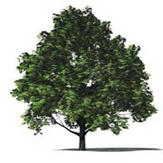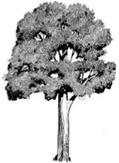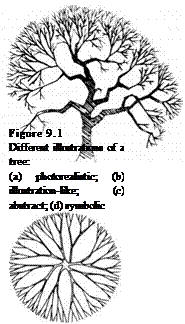In the previous chapters, single plants and vegetation as a whole was described more or less from a botanical aspect. We discussed several methods that were designed to generate single plants and others that combine plant models to form plant communities and associations. To actually generate a realistic-looking image of a landscape, we must transform the so-far produced geometric data into the pixels of an image. This is done similar to shooting with a real camera, whereby the scene is projected onto the film material through the lens.
In synthetic rendering, the geometric data is projected analogously to the real camera using a mathematical projection onto the image plane, and the illumination of each single surface is computed. To determine the surface illumination, approximations of physical lighting processes are used. The illumination values are then transferred onto the pixels of the computer image, meaning that for each pixel in an image we determine which surface will be seen there and which color the pixel has at a respective position.
In the following we deal with several methods for implementing this process. First we will describe algorithms that synthesize photorealistic renditions. Such images are created in such a way that they almost cannot be distinguished from real photographs. Although photorealistic renditions are needed in most cases, we will demonstrate, that in a number of applications, abstract, i. e., “nonphotorealistic” images, are preferred.
As mentioned several times already, the data complexity in plant geometries is the greatest obstacle in efficient rendering. Often the computing time for the transfer of the data is longer than the rendering time itself. Thus, the geometric approximation and the use of special data structures for complex plants play essential roles, especially when scenes have to be synthesized as fast as possible, though, this issue will not be addressed here, but rather in the next chapter. Aside from the appropriate modeling of the plants, we will describe special algorithms designed for their fast rendering. This encompasses the acceleration of conventional algorithms as well as new approaches using alternative definitions and treatments of geometric data.
Chapter 9 Before discussing the details of rendering, we should briefly reflect on a topic Rendering that was already touched upon in the introduction. Due to the vastly differing areas of application, the demands relating to plant rendering also differ greatly. The spectrum of possibilities spans from photorealistic pictures for the film industry to abstract sketches of landscapes in the area of landscape architecture and planning. It is therefore helpful to look at the underlying motivation and the resulting needs for specific rendering techniques with synthetic landscapes.
■ Realism
Especially in the area of film and advertising, the most important characteristic is the realism of an image. Predominantly postprocessing is used to combine real and synthetic images, requiring an absolutely exact adjustment of the lighting conditions and the models used for creating such renditions.
In the film industry rendering efficiency is now less of a problem (at least compared to the work of Reeves and Blau [172] in 1985), because today thousands of powerful computers are used in parallel and they can compute even complex animations in a matter of seconds. However, the vast amount of data is still problematic, and that has to be improved upon. Computer installations often consist of a number of commercial personal computers that are connected through high-speed networks, and each computer calculates images autonomously out of a given sequence.
■ Efficiency/Real Time Computation
In simulation applications and computer games, the frame rate as well as the realism of an object must be taken into consideration. Modern simulation environments require up to 60 frames per second for a smooth simulation. Here, approximation techniques have to be applied to simulate acceptable images with high frame rates.
■ Proportions/Spatial Division
Botany is more interested in the investigation of spatial division, especially for the production of plant associations, meaning that the places from which plants emerge must be emphasized in the renditions. Characteristically, such images do not show any shading, but rather the specific shape architecture ^ of an object. Similarly, in the area of architecture, buildings are surrounded by plants to illustrate their proportions.
■ Visibility Conditions/Spatial Appearance
Visualizations in landscape planning primarily have to reflect visibility conditions and the spatial appearance of the planned landscape. Usually, drawn objects are used, in contrast to the above cases lighting and shadowing are used, since these effects aid the recognition of spatial dimensions in such scenes.

 |
 |
 |
The types of representation for different applications can be illustrated well with a particular tree. Figure 9.1 shows components used in landscape planning, such as a photorealistic rendition, abstract representations, and a symbollike design. Each representation adapts to its respective area of application. Thus the requirements of the rendering procedures must be given different considerations with respect to the individual areas for which they were developed. Realistic images should still be able to be measure up to the quality of photographs, in particular if a combination of computer-generated and real image clips is aimed at. Although computing times no longer play a significant role, developing efficient algorithms for reducing computation expenditure and the quantity of data remains a primary goal, since experience in recent decades shows that the demands for complexity in the data by users often grows faster than the arithmetic performance of computers.
For nonphotorealistic renditions different criteria are decisive, depending upon the respective application. Aspects of the form and the lighting were already addressed. In combination with photorealistic rendering techniques, the spatial coherence is often achieved automatically: If the point of view is moved, ^ spatial coherency the object changes in a foreseeable way, without flickering or producing other visually discernible errors. Such errors would be extremely disturbing in animations and must absolutely be avoided. For nonphotorealistic images, which are often the result of severe simplification processes, the spatial coherence is often difficult to simulate, and thus requires special effort.
The algorithms for photorealistic rendering that will be introduced below are, for the most part, already standard methods in computer graphics. They were developed based on so-called lighting models, a number of which were designed during the past 20 years. The lighting model describes the light distribution in the three-dimensional space. It is usually approximated in such a way that with a justifiable computational cost the lighting conditions for one point of the surface develop. The model is used within the shading process that represents the actual rendering algorithm. The procedure computes the illumination values for all visible surfaces, so that a picture of the scene is generated.
During the early years of computer graphics, displays or screens of today’s quality were of course not available. Usually the pictures were given for output
to converted oscilloscopes, so-called random-scan terminals, or vector monitors where the electronic beam was directly controlled over the screen. The shading applied in the corresponding renditions was therefore only visible as silhouettes of the objects.
 With improved output devices also the lighting models themselves were refined. First, so-called local lighting models were developed, in which the illumination of the surfaces depended solely upon the position of the artificial light source and the view of the user. All interactions between the objects, such as, for example, shadow casting from one object to another object, or the indirect lighting of objects by reflections of light sources from other objects, were here excluded.
With improved output devices also the lighting models themselves were refined. First, so-called local lighting models were developed, in which the illumination of the surfaces depended solely upon the position of the artificial light source and the view of the user. All interactions between the objects, such as, for example, shadow casting from one object to another object, or the indirect lighting of objects by reflections of light sources from other objects, were here excluded.
Later, global lighting models appeared that were able to take all the interactions of objects in a scene into consideration. The light transport between the objects is described using an integral equation system, in which the brightness of a surface potentially depends on all other surfaces.



